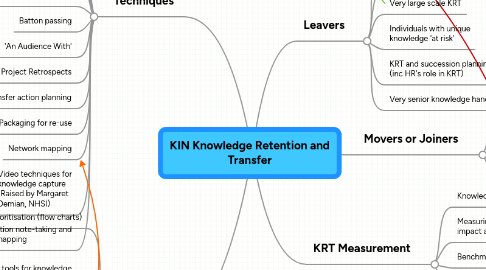KIN Knowledge Retention and Transfer
par Gary Colet


1. Techniques
1.1. Knowledge Elicitation and facilitation skills, (including preparing candidates, raised by Nancy Kinder, Cadbury Kraft)
1.2. Expert to Novice transfer (raised by Jen Webster, HSE)
1.3. Knowledge packaging
1.4. Prioritisation
1.5. Identifying Knowledge Domains or Lenses
1.6. Identifying knowledge recipients/owners
1.7. 'Transfer' when there is no recipient
1.8. Batton passing
1.9. 'An Audience With'
1.10. AAR / Project Retrospects
1.11. Knowledge transfer action planning
1.12. Packaging for re-use
1.13. Network mapping
1.14. Video techniques for knowledge capture (Raised by Margaret Demian, NHSI)
1.15. Elicitation note-taking and Mindmapping
2. Tools
2.1. Prioritisation (flow charts)
2.1.1. Prioritising Individuals
2.1.2. Prioritising Expertise
2.1.3. Prioritising Knowledge 'Domains'
2.2. Self-help tools for knowledge transfer (raised bt Nancy Kinder, Cadbury Kraft)
2.3. Interview tools
2.3.1. Audio
2.3.2. Video
2.3.3. Mixed media (Quindi, Soundnote etc)
2.3.4. Mindmapping
